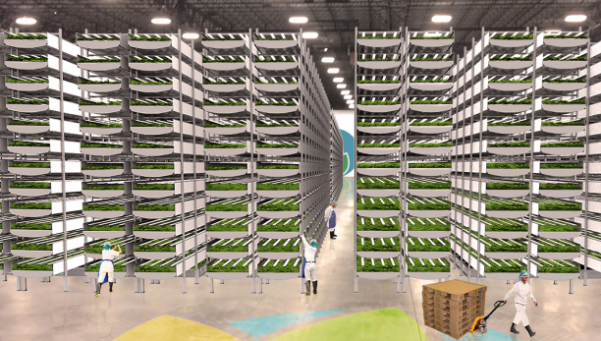Farming in the Sky: Inside a Wall Street-Backed Vertical Farm
Vertical farming isn’t new. The concept—growing crops indoors in stacked layers— has actually been around for over a decade, but it’s only now becoming more prevalent in the United States as well as a hot new area for big investors.
Goldman Sachs (NYSE:GS), Prudential Financial (NYSE:PRU), and RBH Group have partnered with a 10-year-old startup called Aerofarms to build the world’s largest vertical farm in Newark, N.J.
“We want to go where the mouths are. Newark allows us to go to New York City and throughout New Jersey. We’re focused on the places that have economic trouble too—so we can go in and help out,” says David Rosenberg, Co-Founder and CEO of AeroFarms.
The new $39 million facility will transform an old steel mill in Newark’s Ironbound neighborhood. Goldman Sachs, who is picking up the majority of the cost through its Urban Investment Group, says it’s marking an important step in the revitalization of a largely working class area.
“AeroFarms’ innovative vertical farming technology will help boost the local economy, promote healthy food options locally, and support environmental sustainability. Importantly, the project will also create high-quality, accessible local jobs,"says Margaret Anadu, a Managing Director of the Goldman Sachs Urban Investment Group.
Rosenberg says when big companies get involved, it’s a reassurance that our technology makes economic sense.
“They’ve studied our business model and our economics. We are now building our eighth and ninth facility in the U.S. And we have relationships with consumers and big supermarkets. So our economics work,” adds Rosenberg, who expects to produce over two million pounds of leafy greens a year when their new facility opens next year.
Marc Oshima, who’s also a Co-Founder of Aerofarms says the process is quite simple and more importantly bypasses a lengthy, complex supply chain to enable local production at scale—in essence bringing the farm straight to the table.
“It’s a form of indoor controlled agriculture, utilizing as many levels possible of growing beds stacked vertically in a single-story building. We use 95% less water than traditional field farmers, utilizing aeroponics to mist the roots with water and nutrients--offering 70 times greater productivity per square foot annually than traditional farms,” adds Oshima.
Rosenberg says the numbers are key when looking at what they can do all year round as opposed to traditional farmers.
“We can take a seed and grow it in 16 days that otherwise takes 30 days in the field. That enables twenty-two crop turns a year versus three in the field.”
Rosenberg says two things are causing a major shift towards this type of farming today: consumers tastes are changing and the cost to build and run these high-tech facilities are going down.
“People don’t want the chemicals on their food. And we’re able to offer them a residue-free product with no pesticides. Also, the cost of using LED lights have gone down dramatically,” adds Rosenberg.
The Association of Vertical Farming says that while the industry isn’t regulated by the FDA just yet, they see it becoming an emerging trend in agriculture.
“There are currently five medium-to-large vertical farms operating in the United States and over ten smaller ones (mainly growing microgreens and herbs). All of them are planning on expanding. We are estimating that the numbers will double next year,” says Maximilian Loessl, Co-founder and Vice Chair of the Association for Vertical Farming.
Dickson Despommier, a former Columbia University Public Health and Microbiology Professor, who created this concept in his classroom back in 1999 says we’re seeing the birth of this industry right now.
“I think the U.S. will be a world leader in vertical farming because we will be forced to do more of this type of farming—especially because of the situations like we’re seeing in California with the drought,” adds Despommier, who also wrote, The Vertical Farm: Feed the World in the 21st Century.
“Climate change is the big motivator. It’s not vertical farmers versus traditional farmers. It’s more like humanity vs climate change.”




















